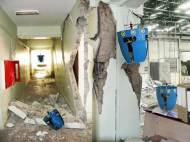AirBurr flying robot navigates in cluttered indoor environments
 Most flying robots aren’t built to recover from shocks after a collision, but a group of researchers from EPFL decided to construct a robot which is suitable for navigation in cluttered indoor environment. Named AirBurr, the flying robot acts like some flying insects and takes advantage of collisions in order to find its way around by deliberately coming into contact with its surroundings.
Most flying robots aren’t built to recover from shocks after a collision, but a group of researchers from EPFL decided to construct a robot which is suitable for navigation in cluttered indoor environment. Named AirBurr, the flying robot acts like some flying insects and takes advantage of collisions in order to find its way around by deliberately coming into contact with its surroundings.
“Four years ago we developed a flying robot that could duck around obstacles, but in a chaotic environment it wasn’t reliable, and it always ended up running into something and crashing and then it couldn’t get back up again”, said Adam Klaptocz, project leader of the AirBurr’s collision energy absorption, self-recovery mechanisms and optimized morphology.
The researchers from EPFL’s Intelligent Systems Laboratory (LIS) designed a robust, autonomous helicopter that could remain airborne after a collision and get itself back up after a fall. AirBurr is even designed to actively seek for collisions with its surroundings in order to use its navigational algorithms which rely on these contacts. While this isn’t ideal in every kind of environment, a combination of several algorithms and additional sensors could make it much more versatile.
Its carbon-fiber fuselage protects its vital parts like an exoskeleton, and its use lowers the overall weight of the robot which is only 0.3 kg (0.66 lbs). Although I agree with the claims from researchers where they said that every additional gram reduces the flight time, I don’t entirely agree with their claim it about it affecting the robot’s maneuverability. While less weight means less inertia and higher agility in ideal conditions, it also contributes to lower control (or even uncontrollable flight) in windy conditions outside the lab.
AirBurr has two propellers installed on the same axis, thus achieving better lift power and control compared to single propeller flying robots. Installed accelerometers and gyroscopes automatically control its orientation, while its four retractable legs can be used as help in a self-recovery system which enables it to recover from positions from which it wouldn’t be able to take-off again.
“We automated it as much as possible”, said Adrien Briod, a PhD student leads the project of AirBurr’s ego-motion algorithms, collision detection and contact-based navigation. “We give it basic indications like ‘get up when on the ground’ but it carries out the maneuver of getting back up all by itself.”
In their first step toward ego-motion estimation, the researchers created a setup with six optic-flow sensors covering a wide field of view. They also devised a method which relies on gyroscope reading in order to automatically calibrate the viewing direction of these sensors.
The prototype will evolve depending on the needs of those who will be using it, and the researchers are working on an improved version. Flying robots are useful for fast exploration of dangerous zones, and future versions of robots built from lightweight, yet resistant and elastic materials should prove handy. While they are useful in exploration and recon missions in cramped spaces where weather doesn’t influence their controllability, I’m still skeptic about its ability to maneuver in more windy conditions due to its lightness, shape and basic fluid dynamics.
I have to comment the EPFL’s press release (and the first video where one of AirBurr’s developers describes the project), where they claim that the current version of AirBurr is suitable for use in irradiated areas, which might be true if radiation levels are low. However, in one of the next sentences of the release the author claims that the drones used in the Fukushima nuclear disaster were slow in the information acquiring process since they were unable to fly near each other.
Flying drones used after Fukushima nuclear disaster flew around the area and collected data about the radiation around the structures. Monirobo robots (robots used to monitor radiation inside Fukushima nuclear plant after the disaster) were used to inspect radiated areas from close range (or indoors monitoring) and they had to carry heavy shielding to protect the electronics and cameras on them.
While eventual breakthroughs might lead to much lighter materials or technologies able to create shielding from the radiation, currently available technologies do not offer a single chance for these robots to operate in scenarios such as Fukushima disaster.
For more information about the project, you can read the conference paper presented at the International Conference on Complex Medial Engineering: “The AirBurr: A Flying Robot That Can Exploit Collisions” [1.5MB PDF].
The LIS team has also recently published the results of the project in the journal IEEE Transactions in Robotics: “An Active Uprighting Mechanism for Flying Robots”.









EPFL researchers revealed a new video where AirBurr navigates a corridor and a narrow doorway towards a light source using the signals from 4 simple photo-diodes. The AirBurr is then programmed to explore a small room using a random direction algorithm similar to the one used by most robotic vacuum cleaners.
http://www.youtube.com/watch?v=dm90IV3tMjI